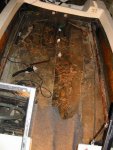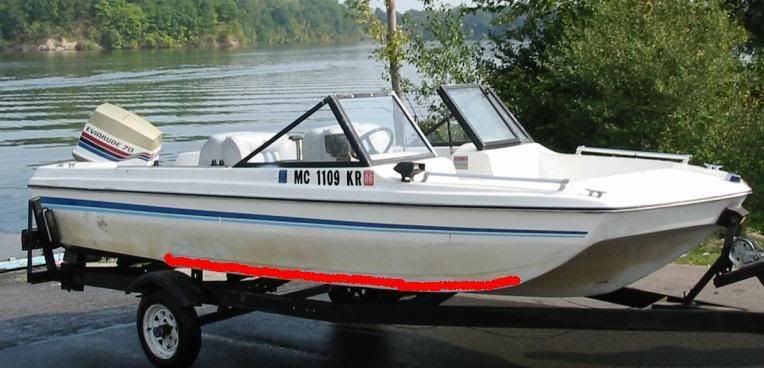Re: Project Sea Sprite
Cougar, the reason for doing the transom 1st is so that when you install the stringers, you can get them up tight against the transom and glue and glass them to it. Why? They help transfer some of the force created by the engine to the bottom of the hull and spread it out, evening out some of the pressures exerted on the sides and bottom of the hull. Some people will add "knees" to the stringers that extend up to the heighth of the transom to help reinforce it and to transfer even more of that energy to the bottom of the hull.
When you cut the floor out, the hull will become very flimsy. You will most likely loose some of the shape of the hull, especially with the cap off.
You might be able to retain most of the shape by cutting 2 or 3 2x4's to the inside width of the hull where the cap was riveted in and use the rivet holes to screw them in place from side to side. This should help keep the shape. If you can criss-cross them, they should also help prevent the hull from twisting if it wants to. Do this before cutting the floor out. Because my cap is mostly still on it's helping to hold the shape of the hull. I still should have pulled the cap instead. There was a way to do it, I just didn't think it out long enough. It didn't bring any more trouble. Just a little more work.
If after bracing the hull, and you still end up with a slight twist in it, that should be straightened out before you glass or glue anything back in.
Especially the floor! If there's a twist and you glass everything back together, that twist will be permanent.
I think I said earlier that pre-measuring stuff before, and as, you're taking stuff out can be very helpful later. Try to be the least destructive as possible. I know however, that sometimes that
is impossible. Save what you can to use as templates or for "reconstructive" measurements.
Think about what you need to do and what other effects it might have and try to minimize them if possible before you do it. Sometimes you have to be a bit creative. That's part of the fun!

Example: Mine didn't have much floor in it when I got it. Nothing left to use as a template. For the floor I made a scale model of it on graph paper, measuring at 3 inch intervals front to back from the center of the boat to the edges of the floor with one square on the graph paper equaling 3". I measured from the bow to the stern and graphed it all out. When I'm ready to start cutting the floor panels I'll be putting a 3" grid on the plywood and then just duplicate what I have on the graph paper.
Measure the heights of the old stringers. In my case, the floor is mostly level with a slight curve towards the center to direct water to the bilge. Knowing that my stringers were 4" high in the back originally, I was able to "copy" the shape of the stringers to the front of the boat. That's in my thread.
When you're thinking about putting stuff back together, think about what got the boat waterlogged and rotted in the first place. Entrapped water. Think about what you can do to correct that little manufacturing flaw. For example, I'll be cutting a "drainage notch" in the bottom rear corners of my stringers so that water can drain into the bilge from the outside edges of the stringers. The areas to the outside of the stringers held water before because they were totally glassed to the transom but not sealed from water. They won't anymore! There are other areas that do the same. Do what's best to make drainage for
all of the water that might get down there.
Last and certainly not least. Safety First! Itching later.
All of this stuff's not really hard at all. Plus, it's fun and extremely rewarding. It can be a bit frustrating at times, but you just take a breather. Ask Oops how he felt on his 1st float or jcsercsa on his 1st time out with his boat. I can't wait to feel that way!
Have fun!

 . I have an attached garage that is insulated (except for the aluminum door) but not heated. I want to be able to work on the project over the winter but I would rather not burn down/blow up the house in the process and from everything I read the vapor from Poly resin is very flameable
. I have an attached garage that is insulated (except for the aluminum door) but not heated. I want to be able to work on the project over the winter but I would rather not burn down/blow up the house in the process and from everything I read the vapor from Poly resin is very flameable  .
.























